Spring Break is coming up in DC! School breaks can be an amazing opportunity to spend time with your child and make sure they’re getting a language rich experience. Often parents feel overwhelmed with choices or may not have many ideas of what to do. You don’t have to go on a trip to make this break an exciting time, and depending on your family dynamics, you may need to stay close to home. Staycations can be fun and give you the opportunity to connect with your child. We’re here to give you some easy and fun ideas of things you can do during your staycation to have fun and really encourage your child’s language development.
Monday: Library and Books
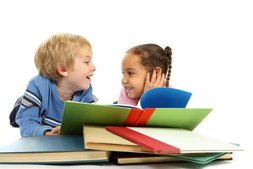
1. Talk about libraries:
- What is inside libraries
- Who works there
- What kinds of things can you do in a library (e.g., read, listen to stories, check out books.)
- What are the appropriate voice levels at the library (inside vs outside voices)
- How we check out books
Giving your child a “preview” about what you may see and do will give them a lot of the vocabulary that is used in libraries. Also, when you prepare your child for the experiences they are about to have, they’ll feel more confident talking about what they see.
2. Discuss how you’ll get to the library. Modes of transportation are almost always an interesting topic for children. Although you may live close to a library, perhaps you’re going to a new library that day for a specific story time or group activity. Will you drive? Walk? Bike? If you live in DC, will you metro? Although grown-ups can get tired of the metro system, it’s usually a novel and exciting experience for kids and gives your child a lot to talk about (taking escalators, metro cards, what lines will you take, what stop will you get off, etc).
4. While you travel to the library, talk about what kinds of books your child might like and how you will go about finding them. Maybe you’ll ask the librarian or look it up on a computer in the library. Also, talk about how many books you will check out.
5. Once you’re done and home, talk about all the steps you took to get to the library. Discuss what you saw, what you did, and what you got. Parents often ask their children, “What did you do today?”, when they have been at school, but it’s just as important to ask this same question when you’ve been with your child all day. It makes it easier to help them recall the sequence and details of events and helps get rid of the “I don’t know” answer since you can help them remember!
Tuesday: Indoor Pools or Water Play Day
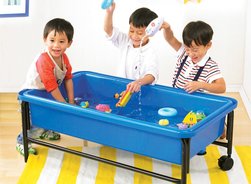
In DC, there are a few indoor water parks; however, if you live in a warmer climate or if the weather if the weather during Spring Break is nice, you may just want to keep the water fun in your own backyard! Either way, there is so much language associated with water play to bring out language in kids.
1. If you are going to a pool, the first thing to talk about is how we interact with water. It’s always a good idea to review how we play in and around water. See how many rules or ways we play in the water (wearing floaties, making sure parent is around in the water, no running on the pool deck, etc.) your child can name. This is a good way to see how much your child remembers about water rules.
2. Whether you are going to the pool or doing water play at your house, you and your child can work on building their vocabulary and association concepts during your water play day.
- Talk about attributes of water (e.g., cold, wet, deep, shallow)
- What we wear in water
- Different bodies of water (pool vs. ocean vs. lake, etc)
- The different things you can see in these bodies of water (e.g.. if heading to a pool, lifeguards)
- If you are going to the pool, what do you need to bring with you (towels, bathing suits, any pool toys, etc)
3. Some kids have difficulty understanding and using negatives correctly (e.g., not, no, none). To target negatives, you can play a sorting game with your child. You can pull some items from around your house and decide if they can go in the water or if they cannot go in the water (this may vary depending on if you are going to a pool or doing water play at home). Then your child can pull out items (either the same ones you did or new ones) and decide if the items go in the water or not. Some examples could be: clothing items, stuffed animals, cars, bath toys, food items. You can talk about if they DO or DO NOT go in water.
4. If you are doing water play at home, you can use this opportunity to work on language concepts to help build your child’s vocabulary. Maybe your child wants to pretend they are in the arctic during their water play– what animals would they see, what would the water feel like, you could even add ice cubes to make it cold or use as glaciers! You can do this for other bodies of water too and add items that go with them (e.g., ocean, lake, pond). This activity is great for building your child’s vocabulary skills by giving opportunities for working on category and association concepts, comparing and contrasting, and even attributes (color, shape, size, number).
Wednesday: Parks and Playgrounds
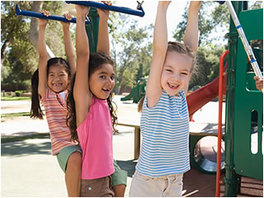
1. Start this activity by talking about which park is your child’s favorite. Every park has so many different features, you can compare/contrast equipment in various parks (e.g.,”They both have slides, but this one has a merry-go-round and that one has swings.”).
2. Once you decide where to go, describe all the parts of the park. Are there sidewalks? What’s on the ground? Think of all the pieces of play equipment. Is it big or small? What colors are there on the play equipment?
3. Discuss how you’ll get there and the steps you take to get to the park. Will you drive or walk or bike or scooter? What do you need for each of these?
.4. Maybe you’ll decide to have a snack or lunch while you are at the park or playground. If so, you can have your child help you prepare and pack your snack or lunch. While doing this you can work on categories (fruits vs. vegetables; drinks vs. foods, etc), comparing/contrasting (e.g., “The fruit snacks are red and the carrots are orange.”) and even sequencing (e.g., while you prepare the sandwich together talk about all the steps you are doing to make the sandwich: first we get out the bread, what do we do next?).
5.. As you’re on the way to the park or playground, describe the things that you see. You can play “I Spy” as you go to draw your child’s attention to what’s in the sky or on the ground or in the street.
Thursday: Cooking
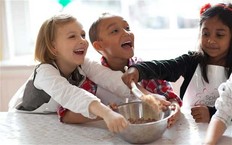
Cooking is a great way to help your child work on sequencing and retelling activities in a hands on way, plus, it can get you to the store to do your grocery shopping!
1. Start by picking one or two (easy) things to make. Fruit salad, cookies, smoothies,or chex mix are some easy and safe things to try out for first time chefs.
2. Make a list of all the ingredients you’ll need for each thing you’ll make. We like to try to draw pictures of the items when we cook, although neither of us are great artists! It will help your child to retell and sequence with pictures, so try it out if you can.
3. Next, go to the store. Give your child 2 items to go find for your recipes (on the aisle you are on). If they find those, see if they can get 3 items. Making this a game will help keep them busy and help them to work on following directions with multiple concepts.
4. When you get home, get the recipe(s) and have your child gather the ingredients as you read them, or vice versa. As you begin ‘cooking,’ try to use sequence words (first, second, third; first, next, last; first, then;before, after, etc) and give 1 or 2 steps at a time (depending on what your child can do). For example: “First wash the strawberries and then cut them.” (for cutting, we like these knives)
5. Having your child tell you what things are used to perform certain tasks is another good language activity (e.g., “What do we use to cut the fruit?”, “What do we use to bake the cookies?”). Or, have them get things in categories (“Get all the fruit.” or “Get all the utensils.”, etc).This will help your child begin to think of objects in different ways, build associations, as well as, their vocabulary.
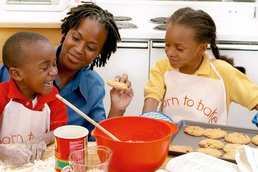
6. When you’re ready to eat, try to work on describing the foods. You can use categories, color, taste, size, temperature, and/or texture. Then, bon appétit!
Friday: Around the House
There are some common items around your house that kids will love to play with. Feel free to experiment and see what piques your child’s interest and creates the most language-rich experiences.
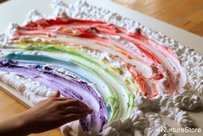
1. Shaving cream is one of our favorites. Most children really love squishing their hands in shaving cream and there’s a lot to talk about as they do. The color, how it feels, what you could pretend that it is, what you can draw in it…the list could go on and on! We love to put small animal toys and pretend it’s snow, or drive cars through shaving cream and pretend it’s a car wash, or draw in it (a great way to practice making letters or shapes).
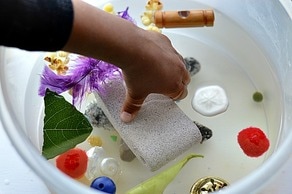
2. Water in a tub or bucket is another great idea. Kids love water for some reason (unless they have to take a bath!). Get bowls, measuring cups, lids- anything around the house that could scoop up water. You can also do experiments with various objects (e.g., coins, tissues, pencils, figurines, blocks) to see which items float and which ones do not
3. Tape is surprisingly exciting to use in order to make pictures or just to play with. We like the Washi tape or duct tape with different patterns to make pictures. You can put them on paper or make designs on the sidewalk. Have them tell you about the colors, shapes, or designs they make.
4. If it’s a nice day and you have a good patch of sidewalk or walkway in front of where you live, grab some chalk and go outside! We like to play hop-scotch, which is a fun way to work on counting! You and your child can draw the hop-scotch squares together or you can each have your own hop-scotch squares. You can also take the opportunity to work on things like categories (e.g., “Let’s draw zoo animals” or “Let’s draw some food for our outside pretend snack! Should we draw vegetables or desserts?”,), attributes (i.e., colors, shapes, size, number), prepositions (e.g., “Let’s draw a sun above our flowers.”, “Our house needs a door. Should we put it under the windows or next to the windows?”),
5. Build a marble tower out of recyclable materials around your house! Think of all those paper towel rolls, toilet paper rolls, yogurt containers, bubble wrap, boxes and other things you collect over just one week. You and your child can work together to build your very own, homemade marble tower. This activity is really great for problem-solving, team work, making predictions, coming up with solutions and getting creative. You can even YouTube a video before you start building so your child can get excited and inspired about the different possibilities.
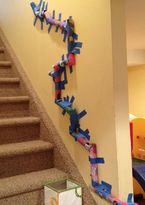
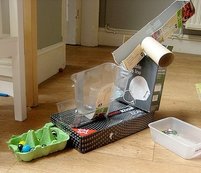
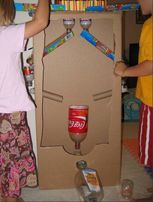
We hope you and your family have a great Spring Break! Maybe you have some favorite staycation ideas you and your child do together? Feel free to share your ideas in our comments section.
If you are having concerns about your child’s development reach out to us at The Speech Space. We offer free screenings, which take approximately 30 minutes, and can help identify potential problems.
